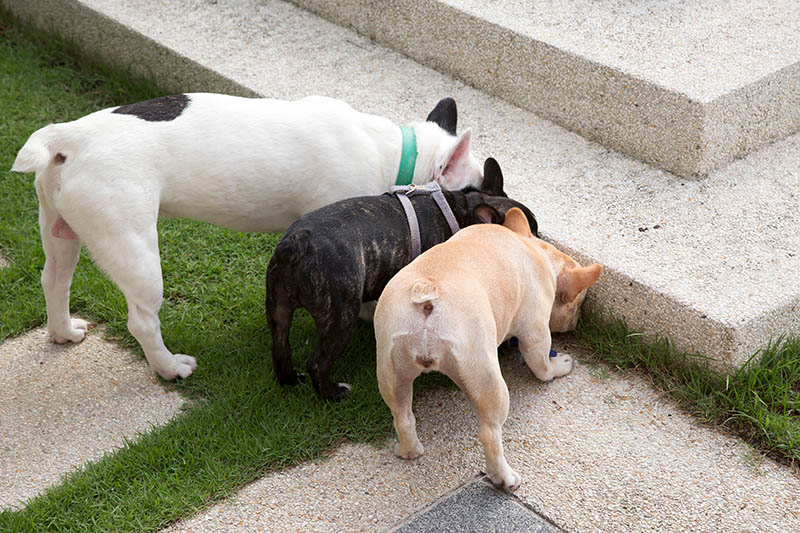Click to Skip Ahead
Anal sacs are a normal part of the anatomy of the perineum (the area between the anus and the external genitals) of dogs. Dogs have two anal sacs, with one on either side of the anus. These sacs are lined by glands (apocrine and sebaceous glands), which produce anal gland secretions that are important for marking territory and identification. A small amount of fluid is typically secreted from these sacs each time a dog defecates.
Diseases of the anal sac are relatively common in dogs, particularly adult dogs, with the incidence of disease varying between 4.9–15.7% depending on the population.
Below, we’ll delve into this group of conditions a bit further and explain why French Bulldogs are sadly overrepresented among dog breeds most often diagnosed with anal sac disease.
What Diseases Can Affect Dog’s Anal Sacs?
There are two categories of anal sac disease (ASD) in dogs, namely, non-neoplastic (or non-cancerous) anal sac disease and neoplasia (cancer involving the anal sac). The non-cancerous processes can be further divided into anal sac impaction, inflammation (or anal sacculitis), and abscessation. Anal sac disease, in general, is considered a relatively common reason for the presentation of a dog at a veterinary clinic.
Anal sac impaction is defined as an enlargement of one or both anal sacs because of the retention of contents within the sacs. Typically, the anal sac contents are thick, and expressing impacted glands can be quite difficult. Dogs can have either one or both glands impacted at the same time.
Anal sacculitis refers to an enlarged sac or sacs along with evidence of inflammation of the anal sac. Dogs with such inflammation tend to present with reddened skin over the perineum, which is also often swollen and painful. Abscessation of one or both anal sacs is often accompanied by a fever, along with reddening of the skin overlying the anal sac and associated hair loss.
Abscessed anal sacs are usually painful and show significant swelling in the area. In cases where the abscess has ruptured, a bloody or purulent (i.e., containing pus) discharge may be seen draining from the site via fistulas/tracts to the skin over the perineum.

What Are Potential Risk Factors for Anal Sac Disease in Dogs?
In the various studies looking at ASD in dogs, several breeds have been identified as being either predisposed or at increased risk for developing ASD. Amongst these breeds are the Chihuahua, Labrador Retriever, and French Bulldog, with small breed dogs (<10 kg) being the most reported breed size diagnosed with ASD.
Other recognized risk factors include dermatological and gastrointestinal diseases. Gastrointestinal diseases such as inflammatory bowel disease (IBD), bacterial enteritis, and an adverse food reaction (with predominantly gastrointestinal signs) can lead to clinical signs of diarrhea, which in turn can impact the normal secretion of the contents of the anal sac with defecation. Typically, with passing soft stool or diarrhea, the anal sacs are generally not expressed, and this can lead to retention of material within the sacs and subsequent impaction, etc.
Also, diarrhea can lead to irritation and even swelling of the perineum, which can contribute to occlusion of the anal sac duct, and subsequent impaction, inflammation, or even abscessation. That being said, not all dogs with either soft feces or diarrhea will go on to develop ASD.
Because the anal sacs are typically considered part of the skin in the perineum, underlying dermatological/skin diseases can thus affect these structures and lead to inflammation of the lining of the anal sacs (anal sacculitis) and other potential complications. Examples of such conditions include a cutaneous adverse food reaction and atopic dermatitis.
Obesity is another contributing factor to the development of ASD because an increase in the amount of fat in the perineum is believed to compress the anal sac ducts, which in turn prevents regular expression of anal sac contents with each bout of defecation, and results in retention of contents within the anal sac. The season of the year may also have a minor role to play with ASD in dogs, with the incidence of the disease being higher during spring and summer months, potentially because of a link between ASD and atopic dermatitis, which is seasonal in nature.
What Are Common Clinical Signs of Anal Sac Disease?
Anal sac disease generally causes pruritus (itching) of the perineum. This can manifest clinically as licking or biting of the perineum or the area around the tail base, tail chasing, scooting behavior, pain or discomfort when trying to sit down, straining/difficulty or pain when trying to defecate, redness of the perineum and tail area, swelling of the perineum potentially with associated hair loss, presence of a bloody or purulent discharge from the perineum.
While the above signs strongly suggest ASD, realizing that other disease processes can also present with similar signs is essential. Examples of these other diseases include parasites, tumors of the perineum, fistula in the perineum (often breed-specific, with German Shepherd Dogs most commonly affected), flea allergies, and bacterial infection of the skin. Your veterinarian can assist with distinguishing ASD from these other disease processes, often by starting with a thorough physical examination and a rectal examination with palpation of the anal sacs.

How Is Anal Sac Disease in Dogs Treated?
Various treatment options have been used in managing dogs with anal sac disease, and more often than not, a combination of such treatment strategies is needed.
- Expressing the anal sacs
- Flushing the anal sacs
- Warm packing over the perineum
- Administering anti-inflammatory drugs
- Use of topical antibiotics or antibiotic-corticosteroid preparations
- Prescribing systemic antibiotics in more severe cases, particularly those with a fever
- High-fiber diet
It is crucial with cases of ASD to address any potential underlying risk factors for the disease process, including treatment of associated dermatological and gastrointestinal diseases. When managing anal sac abscessation, if the abscess has not ruptured, an incision should be made over the anal sac to allow for drainage of the anal sac contents/pus.
If a combination of the above treatments fails to control the ASD or a significant recurrence of the disease is noted, the next step would be to consider surgical removal of the anal sacs (anal sacculectomy). Anal sacculectomy can also be used to manage severe cases of ASD where fistulae/draining tracts have formed in the perineum.
Are French Bulldogs at Increased Risk for Anal Sac Disease?
Unfortunately, French Bulldogs are at increased risk for anal sac disease. A recent study reported that brachycephalic dogs (dogs with shortened snouts) generally have 2.6 times the odds of developing ASD compared to dolichocephalic breeds (dogs with long and slender noses, e.g., Greyhound).
This increased risk is believed to be secondary to their predisposition to some of the risk factors mentioned. In other words, they are more likely to have ASD because of the common incidence of either dermatological or gastrointestinal diseases in French Bulldogs.

My Frenchie Has Already Had Anal Sac Disease. Does It Recur?
Unfortunately, across all breeds, recurrence of anal sac disease is very common. A recent study reported recurrence rates of 35.7%, 6.3%, and 2.9% for anal sac impaction, inflammation, and abscessation, respectively.
The recurrence of anal sac impaction and anal sacculitis was typically seen after a period of 4–5 months; however, previous reports have shown recurrence after as little as 2–3 weeks following the expression of anal sacs in dogs with ASD.
How Can I Prevent Anal Sac Disease in My French Bulldog?
Expression of anal sac contents is a normal process that generally happens with each bout of defecation. Regular manual expression of the anal sacs should be avoided, as such expression can cause trauma which, in turn, increases the risk for swelling, inflammation, and later scar tissue formation. These changes can lead to impaction, anal sacculitis, or even abscessation.
High-fiber diets can sometimes be useful in adding bulk to feces, promoting the expression of the anal sacs with defecation. Dietary modifications may also be necessary if your French Bulldog has an adverse food reaction. Your veterinarian may recommend trying a new diet with a protein your dog has never eaten before. However, sudden changes in diet should be avoided, as this may cause changes in stool consistency, which can reduce normal expression of the anal sacs.
Given that obesity may also play a role in the development of ASD, it is important to maintain a healthy weight with your Frenchie.
Featured Image Credit: eva_blanco, Shutterstock











